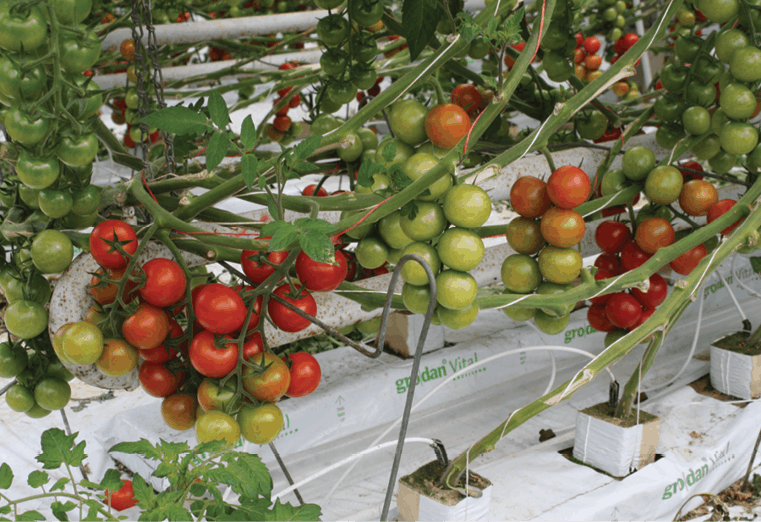

Producing food crops in greenhouse and controlled environments is an increasingly popular idea. Whether the goal is to offer fruits and vegetables when field production is not possible, have predictable yields, or increased control over factors such as food safety and/or produce quality, controlled-environment agriculture provides opportunities. In these environments, hydroponic systems are an essential part of production. This article will provide an overview of the most widely used hydroponic systems in CEA.
Systems for leafy crops
Leafy crops, such as lettuce, culinary herbs and other leafy greens are characterized by a relatively short crop time, small size and high planting density. The most widely used and most recognizable system for growing leafy crops hydroponically indoors is the nutrient-film technique system (NFT) system. The main feature of NFT systems are the channels plants are placed into and subsequently grow in. Available in a variety of dimensions, channels typically measure approximately 4 inches wide and 2 inches deep and 8 or more feet long.
Seedlings grown in rockwool, phenolic foam, or other stabilized substrate are placed into holes between 1 and 2 inches which are cut either out of lids that affix to channels for two-piece models or simply on the top of the channel for one-piece models. The channels are typically placed approximately waist-high, which facilitates comfortable planting, plant maintenance and harvest. Channels are on a 1% to 3% slope, which allows the nutrient solution to flow from the top to the bottom of the channel, bathing roots in a thin “film” of solution at a rate of 1 to 2 liters of nutrient solution per channel per minute.
These NFT systems are popular for a variety of reasons, including their comfortable working height as well as the naturally high oxygen concentrations in the nutrient resulting from solution movement. However, one of the challenges growers often face is when the pump providing nutrient solution goes down or clogs during irrigation plants don’t have long before damage occurs.
The other popular system used for leafy crops is one with several names: deep-water culture (DWC), deep-flow technique (DFT), raceway or raft culture. Regardless of the name, the idea and system are the same. Raceways are constructed out of different materials from poured concrete, metal frames, polystyrene foam and rubber liners, and sometimes even cinderblocks and plastic. In these pools, rafts float in a nutrient solution that is 4 to12 inches deep. As “raceway” indicates, the rafts are planted on one end of the pond and harvested at the other. As rafts are harvested, they move forward towards the harvesting side. This design is efficient for labor, as planting and harvesting are concentrated at specific areas. When using DWC systems, the nutrient solution must be aerated or oxygenated to maintain sufficient oxygen concentrations for plants, as these systems do not provide the natural aeration that NFT does.

Systems for vining crops
Compared to leafy crops, vine crops including tomato, cucumber and pepper are much larger in size, with lower planting densities and longer crop cycles. While those systems used for leafy green production are not well-suited for vine crop production, there are two systems that are very popular for vine crops: slab culture and Dutch buckets.
Slab refers to plastic bags containing rockwool or coconut coir, with the most popular sizes measuring approximately 36 to 39 inches long, 6 to 8 inches wide, and 3 to 4 inches tall. In order to modify the water holding capacity, air space, and other physical properties of the substrate, rockwool fibers are packed at different densities and fiber orientation can be rearranged, whereas different blends of crushed and shredded coir are used to vary physical properties.
These slabs are often placed on hanging gutters or in troughs on the floor to facilitate drainage of excess nutrient solution. Before plants are transplanted into the slabs, they must be “prepared.” Drip stakes are placed into the rockwool or coconut slabs, and nutrient solution is provided until the bags are full. Be sure to not cut any slits in the slabs prior to filling with nutrient solution, as it would cause them to drain immediately.
The slabs can be left saturated for approximately 24 hours. For rockwool, this period allows the pH of the substrate to adjust to that of the nutrient solution, which is initially higher than desired for producing greenhouse plants. For coconut coir slabs, this preparation period not only serves to leach excess salts from the coir, but also to decompress the slabs from the compressed form they are shipped and sold in. Dutch, or “bato,” buckets, are another system commonly used for vining crops. These buckets are filled with a loose substrate, typically either coarse perlite or lightweight expanded clay aggregate (LECA). In the bottom of each container is an auto-siphoning elbow that helps drain excess nutrient solution out of the container to prevent overly saturated substrate. To prevent the siphoning elbow from getting clogged with perlite, either cover it with a small piece of screen, or put a few handfuls of LECA around the elbow to act as a filter. Since the area of exposed substrate is greater in a Dutch bucket than in slabs, covers can be placed over the substrate to minimize algae growth and development.
Irrigation in both system is similar, with a nutrient solution is delivered to plants via drip irrigation.
The take-home message
The hydroponics systems discussed here are the four most popular hydroponic systems. However, hydroponic systems encompass a wide spectrum of different technologies and systems, and there are others not mentioned here, as well as deviations from what is described in this article. Regardless, the systems described in this article are going to be a great place to start for those interested in growing leafy greens and herbs or vining crops.

Explore the April 2021 Issue
Check out more from this issue and find your next story to read.
Latest from Produce Grower
- Chilli thrips (Scirtothrips dorsalis)
- GS1 US Celebrates 50-Year Barcode 'Scanniversary' and Heralds Next-Generation Barcode to Support Modern Commerce
- University of Florida offers Greenhouse Training Online program on irrigation water
- Flower trends in full bloom
- Nominate an outstanding leader
- New Florida Extension Agent Will Teach Stakeholders About Food Safety
- Paint it black
- Regular checkups





